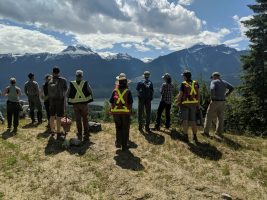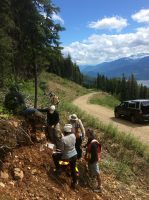Field Soil Description & Classification Course
- Start Date: June 15, 2022
- End Date: June 17, 2022
- Time: 9am-5pm Pacific
- City: Revelstoke BC
- Venue: Various field sites, classroom component and morning meeting spot at Revelstoke's Okanagan College, 1401 1 St W
- Instructor: Deepa Filatow, lead instructor
- This course has been delivered. To be put on a notification list for the next course, send an email to [email protected].
Course Description
 This course will cover procedures for observing, measuring, and describing soils in the field. The goal is to produce consistent data for soil inventory, mapping and classification using techniques that improve the consistency of determining soil properties in the field. Students will gain experience with describing and classifying forest and wetland soils in the Revelstoke area using soil horizons and properties measured in the field. Students will discuss how soils data collected in the field can inform soil management practices relating to conservation, agriculture, forestry, mining, and oil & gas activities.
This course will cover procedures for observing, measuring, and describing soils in the field. The goal is to produce consistent data for soil inventory, mapping and classification using techniques that improve the consistency of determining soil properties in the field. Students will gain experience with describing and classifying forest and wetland soils in the Revelstoke area using soil horizons and properties measured in the field. Students will discuss how soils data collected in the field can inform soil management practices relating to conservation, agriculture, forestry, mining, and oil & gas activities.
The course starts in the classroom where students will have the opportunity to meet with one another and the instructor team. The morning will be spent reviewing soil attribute data recording requirements, soil taxonomy, and field techniques. That afternoon in the field we will practice the procedures for observing landscape context, site selection, and soil pit excavation. Participants will describe and record soil horizon designations, depths for organic and mineral layers, soil texture, soil colour, % coarse fragments, structure, pH, roots, pores, carbonates, effervescence, clay skins, mottles, rooting depth, drainage, seepage water depth and root restricting layers. Horizon designation and other criteria will be used to classify the soil. We will conclude each site with a reporting out and discussion of management implications. The next two field days students will continue to practice these skills and visit a variety of different landform and soil types.
A detailed course outline is available upon request.
Revelstoke is a fantastic location for this course as there are a wide variety of soils accessible to students that in other locations you would have to travel great distances to be observe! Additionally, this course comes with one lead instructor and up to three assistant instructors who collectively have over 100 years of experience!
Our Instructors
 This course has an incredible teaching team with four instructors and a small group size of ~15 students.
This course has an incredible teaching team with four instructors and a small group size of ~15 students.
Deepa Spaeth Filatow, lead instructor
Deepa Spaeth Filatow, P.Geo, P.Ag. is an ‘earth science generalist’ and an expert on the provincial standards and holdings of surficial geology, ecosystem and soils information for British Columbia. This includes 1000 GIS projects with a total of 25 million inventory polygons; 26 000 soil pit descriptions; scanned and georeferenced legacy maps; and associated standards, reports and field data. Deepa has been the Provincial Bioterrain Specialist for the Ministry of Environment since 2001. She is a Professional Geoscientist with the Association of Professional Engineers and Geoscientists of British Columbia and a Professional Agrologist with the BC Institute of Agrologists. Deepa spent many years mapping ecosystems, soils and terrain in all regions of the province and has had the privilege of working in interdisciplinary teams with top notch ecologists, soils scientists, GIS specialists, wildlife biologists, planners, engineers, agrologists, anthropologists and foresters.
Mr. Wayne A. Blashill, assistant instructor
Wayne Blashill is a Professional Agrologist (PAg) with 40 years of experience in soils and ecology work. He has worked throughout BC, also in Alta, Sask. and in the USA on soil survey, TEM and PEM. He is currently a consultant in Summerland, BC.
Mr. Blashill has taught Basic Forest Soils and Silviculture Prescriptions for the BC Continuing Studies Network (Kamloops), Inland Timber Management (Williams Lake) and Canfor (Chetwynd). He has knowledge in botany, evaporation theory, soil water balance modelling and soil chemistry. He recently completed soil survey on 325 vineyards in the Okanagan and Similkameen for the Summerland Research Station.
He has a BSc in Ecology from the University of Victoria and was an MSc candidate at the University of British Columbia Soil Science Department. He’s done soils field work with pedologist’s Terry Lord & Alex Green (Vancouver) and Charles Tarnocai (Ottawa).
Chuck Bulmer, assistant instructor
Chuck Bulmer, PhD, P.Ag., Retired Soil Scientist with the BC Ministry of Forests. Chuck conducted research on a wide variety of topics in soil science for more than 25 years. His research interests include digital soil mapping, evaluation of properties and processes in BC’s forest soils, and studying growth limiting conditions in degraded and rehabilitated soils. Chuck is an adjunct assistant professor at University of British Columbia and also works with the Canadian Digital Soil Mapping Working Group.
Jessica Lowey, assistant instructor
Jessica Lowey, PAg, is a practicing environmental consultant with years of hands-on and academic experience with with soils classification, mapping, restoration, and salvage experience. She has experience with large scale TEM projects, Phase I/II ESAs, soils classification and carbon storage sampling for MFLNRORD. Jessica has a passion for soils and sharing her knowledge with others having taught a number of related topics in the past.
Who should take this course?
This course is designed for people working in agriculture, forestry, mining, oil & gas, resource management, or government agencies (Forest Service, Regional District) who may require initial or additional basic soils knowledge. Staff doing soil reclamation & remediation or reviewing soils data collected by consultants would benefit. TEM and PEM practitioners will have interest in this course. All are welcome.
Preparation and what to bring
Publications

It is recommended that students come having reviewed the following publications, and to have the publications/resources either printed or on their phone. All are available on-line:
- Field Manual for Describing Terrestrial Ecosystems. 2010. LMH#25.Pre-read section 2 Soils Description. Used to describe all soil attributes. **Highly recommended that each student have their own copy, although the instructor will have a two copies to share. See here
- The Soil Landscapes of BC. 1986. Please pre-read section three, and read section 3.5 as it addresses the Columbia Mountain and Southern Rockies soils. It’s old but still relevant! See here
- The Canadian System of Soil Classification. 1998. Used to classify soils, the instructor can share his copy with students, but students may want their own copy for future use. See here
Field equipment
Each participant must have:
- Sturdy hiking shoes (for uneven terrain and shovelling)
- Waterproof boots (for wetland site)
- Rain gear (jacket and pants)
- Warm layers
- Pack or field vest to carry gear
- Reflective safety vest
- Water bottle (at least 1L)
- Trowel (garden trowel)
- Soil knife (can use an old cutlery knife)
- Tape measure
- Golf tees (for horizon markers could use large nails)
- Field Manual for Describing Terrestrial Ecosystem LMH 25 (loaded onto field mobile device)
- Canadian System of Soil Classification (loaded onto field mobile device)
- Field note book
- Mechanical pencils
- Mobile device (communication, soil classification app, photos, resources, gps, etc.)
- Packed lunch
It would be nice if participants have:
- Clip board
- GPS
- Plastic bags (large ziplocks)
- Hand lense (10x or higher)
- Measuring spoons (for soil texturing)
- Hard copy of Canadian System of Soil Classification
- Small soil sieve
- pH litmus paper (can get from a pool supply store) or pH meter
- 10% HCl (hydrochloric acid for carbonates)
- Root saw and/or pruning clippers
- Clinometer
- Compass
- Small umbrella
- Camera
- Water spray bottle
We need some extra items in the following list but not necessarily one for every person. To help with our planning we’ll be asking if you can bring any of the following in the registration form:
- Hard copy LMH 25
- Munsell Soil Colour Chart
- Field capable vehicle (for gravel roads)
- Shovel
- Truck or hand radio with RR stations programed
- First aid kit
What is included with the course?
There is no workbook or manual for this course. The 3 publications listed above provide all the background & technical procedure. The field sheets contain all the soil description data and are the only hardcopy deliverables. Lunches are available for pre-order with registration.
Registration
This course has been delivered. To be put on a notification list for the next course, send an email to office@cmiae.org.
COVID19 Protocol
CMI will be following the guidelines provided by the Province of BC’s Public Health Authority to keep us all safe during the COVID19 Pandemic. See here for current protocols – all students must review this document before the field component of this course.

